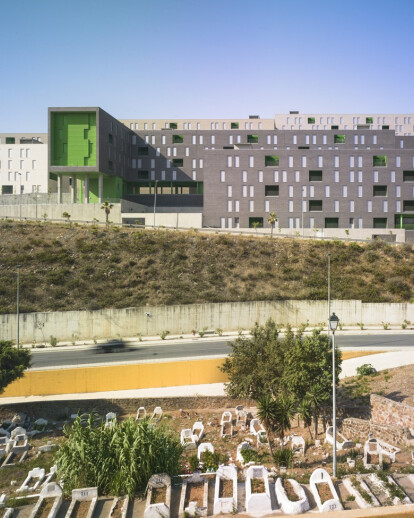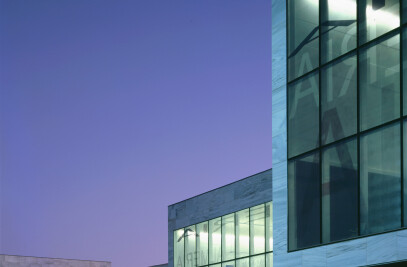Given the uniqueness of the initiative designed to provide subsidised housing based on an attitude that is contemporary and sensitive to current social trends, a comprehensive strategy has been adopted based on an interpretation of the PLACE and typological research based on improving living conditions and processes in order to give rise to quality housing that is sustainable and adapted to the various considerations that influence the construction of the architectural concept.
“Then she began looking about, and noticed that what could be seen from the old room was quite common and uninteresting, but that all the rest was as different as possible”. Lewis Carroll.
We understand the place as being an accumulator of situations, elements or events that are built as a single concept based on a broad and complex vision that establishes guidelines for recognition that go beyond the strictly visual or physical values. The place we envisage has wind, light, malleable spaces, the future memory of the inhabitants, in addition to certain property development patterns that are already established.
Based on this interpretation, an intervention is proposed that is tailored to the circumstances pertaining to the place and attempts to integrate itself as an abstract element superimposed by means of a geometric pattern that governs the entire operation. This framework allows us to streamline all the factors pertaining to the project in order to propose an overall approach that is unitary both in terms of construction and urban design.
We bring into play a range of parameters aimed at creating an independent fragment of a city that reconstructs perceptive essences associated with an understanding of the place itself. Empty spaces, squares, streets, vantage points and courtyards are configured as basic elements in order to define our new "neighbourhood."
Due to the sharp slope of the plot (40 metres of height difference), the proposal is to amend the topography by means of a series of terraces integrated into the geometric framework, with slopes of approximately 5 metres, and on which the various buildings will stand. These buildings will adapt to the different slopes, adopting a winding pattern to seek better orientations and spread out in a south to north direction (which corresponds to the orientation of most of the blocks). In addition, this arrangement will occur in relation to the adjacent streets in order to allow pedestrian access to various points on the plot. The buildings are proposed in a way that gives greater importance to the empty space and to their relationship with the terrain than to their own or independent form. In this way the buildings adapt to the topography, either supported or "floating", focusing on the continuity of spaces, of visual relationships, orientation, etc.
The topography, based on the initial regulatory framework, forms spatial situations that are carved geometrically and that hollow out or empty the pre-existing reality. The buildings are proposed in a way that gives greater importance to the empty space and to their relationship with the terrain than to their own or independent form.
A mixed (mostly residential) programme is envisaged based on the inclusion of 317 subsidised dwellings (32,742.46 sq. metres) and various commercial premises that are strategically distributed around different parts of the plot (2,472.49 sq. metres in total), together with the necessary provision of parking spaces that are available associated with each building in the basement floors that occur in the staggered layout.
The aim, from the external perception of the project, is for the continuity of space, and the staggered arrangement, with the ground floors that become covered areas that can be walked under, and the possibility of moving around the various plots as a neighbourhood where urban situations such as squares, vantage points, streets, etc. occur, gives the whole project qualities that depend more on the life of its inhabitants than on the architecture.
The idea is a building model that aims to improve the quality of life by using systems that optimise the conditions of use and energy saving, encouraging wherever possible the use of the area's own natural resources. The degree to which the sun falls on the façades depends on the orientation (north-south) and is controlled by means of a "deep façade" system (whose depth varies depending on the orientation, deeper to the south and less so to the north), thereby ensuring that in summer the sunlight does not directly impact the inside of the dwellings, thus maintaining better climate conditions, and in winter (when the sun is lower), shining in directly to heat the rooms. A cross-ventilation system is proposed, since all the dwellings have double orientation. This system is based on an inner courtyard connected to the outside by terraces that change their orientation to improve air circulation and keep the homes continually ventilated.
We build buildings based on a base rate adapted to the size of the personal or family units that inhabit them. The typology is based on a rational model generated by 3.00 x 2.80 metres and 3.30 x 2.80 metres grouped together depending on needs of use. Each module has its own use: bedroom, living room, dining room, terrace, and to these are added bathrooms and hallways. The diversity in positioning the gaps, terraces, patios and empty spaces in general seeks to establish internal spatial continuity, by establishing internal relationships between the dwellings and improving the performance and energy efficiency of the buildings. All the homes have double orientation, terraces and inner courtyards. In addition, a filter-storage façade is proposed.
The dwellings can be very versatile, changing the use of the rooms according to the needs of the inhabitants or to the times of the year in order to optimise the orientations. The kitchens are located adjacent to the courtyards and there is a laundering-drying area on the terraces. Types of dwelling with 2 bedrooms, 3 bedrooms (the majority) and 4 bedrooms (large families) are proposed.
Construction team: Antonio G. Liñán, Antonio González Cordón, Luis E. Villar
Project Team: Luis E. Villar, Víctor Silveira, Esteban Valencia, Mª Luz Villar, Daniel Montes, Jose G. Mora, Sara Speranza

































